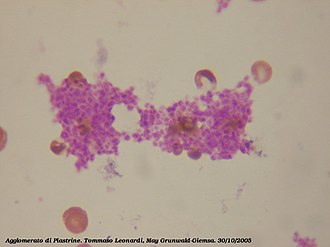Thrombocytes
Platelets (adhesion, activation, aggregation):
Platelets and vWF:
Thrombocytes, or platelets, are non-nucleated blood elements that play an irreplaceable role in stopping bleeding (hemostasis).
Physiological values[edit | edit source]
The normal platelet count in the blood is around 150–300 · 109[1][1] in 1L.This value does not depend on age or gender. A decrease in platelet count below the physiological limit is referred to as thrombocytopenia, an increase as thrombocytosis. Approximately 2/3 of platelets are found in the bloodstream and 1/3 in the spleen.
Formation and destruction[edit | edit source]
Platelets are formed from megakaryocytes in the bone marrow. Megakaryocytes are large cells with a polyploid nucleus. As they mature, they extend their protrusions into the sinusoid of the bone marrow. When passing through the capillary wall, the most massive cleavage of fragments occurs, which is released into the blood. Thus, platelets are not real cells, but only fragments of the cytoplasm of megakaryocytes. Up to 5,000 platelets are formed from one megakaryocyte.
The development of megakaryocytes in the marrow (megakaryocytopoiesis) is stimulated by thrombopoietin and influenced by a number of other substances. Platelets live for 9-12 days and most die by being absorbed by the vascular endothelium.
Morphology and metabolism[edit | edit source]
Platelets are the smallest blood elements, they have the shape of disks with a diameter of 2–4 μm, a thickness of 0.5–1 μm and a volume of 4–8 fl. They are nuclear-free (therefore they do not undergo proteosynthesis). They contain mitochondria (production of ATP and ADP) and residues of the Golgi apparatus and the endoplasmic reticulum (storage of calcium ions). In the cytoplasm there is a system of interconnected channels connected to the surface of the plate (importance for secretion). The dense tubular system in the cytoplasm contains enzymes for the synthesis of arachidonic acid derivatives.
There are 3 types of granules in the plates:
- alpha granules contain: von Willebrand factor (vWF), platelet factor 4, PDGF, fibrinogen, thrombospondin, factor V (proaccelerin)a
- dense granules contain: ADP, ATP, Ca2 +, serotonin,
- lysosomes contain lysosomal enzymes
Substances from platelet granules are used for vasoconstriction at the site of injury, hemocoagulation and subsequent repair of the injured vessel.
The cytoplasm contains actin and myosin (platelet constriction is important for the release of granule contents). The shape of the platelets is maintained by marginal microtubules under the membrane (formation of pseudopodia in the formation of a temporary plug). The contractile protein thrombostenin also actively alters the shape of the plate.
The platelet membrane contains phospholipids. Platelet phospholipids represent the so-called platelet factor 3. Phospholipids in the platelet membrane are necessary for the activation of some coagulation factors. In addition to phospholipids, the membrane also contains glycoproteins which prevent the platelets from adhering to the undamaged vessel wall and, conversely, allow the platelets to adhere to the damaged wall.
Function[edit | edit source]
Platelets play an important role in hemostasis
- Adhesion - Platelets adhere to exposed subendothelial collagen. The von Willebrand factor is applied during adhesion.
- Aggregation - Platelets aggregate through fibrinogen, for which they express receptors.
- Constriction - thanks to contractile proteins, the shape of the platelets changes and the active substances are released.
- Thrombus formation - a white or platelet thrombus (temporary hemostatic plug) is formed. Its further transformations are part of the process of hemocoagulation.
- Healing - Platelets contain substances such as PDGF (Platelet Derived Growth Factor), which have proliferative effects and are used in the regeneration of injured tissue.
Links[edit | edit source]
Related articles[edit | edit source]
Reference[edit | edit source]
Used literature[edit | edit source]
- TROJAN, Stanislav, et al. Lékařská fyziologie. 4. vydání. Praha : Grada, 2003. 771 s. ISBN 80-247-0512-5.
- KITTNAR, Otomar, et al. Lékařská fyziologie. 1. vydání. Praha : Grada, 2003. 790 s. ISBN 978-80-247-3068-4.
- ŠVÍGLEROVÁ, Jitka. Trombocyt [online]. Poslední revize 2009-02-18, [cit. 2010-11-13]. <https://web.archive.org/web/20141108073650/http://wiki.lfp-studium.cz:80/index.php/Trombocyt>.



